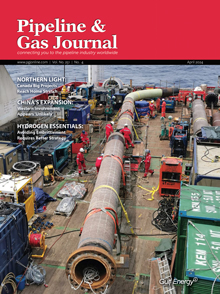Carbon+Intel: DNV Supports First Large-Scale Testing of Submerged CO2 Pipelines
DNV, an energy expert and assurance provider, is working with Wintershall Noordzee and the OTH Regensburg University of Applied Sciences to explore how existing natural gas pipelines in the southern North Sea can be used for future carbon dioxide (CO2) transport.

The work scope entails large-scale CO2 pipeline testing of running fracture in submerged (water) condition, which is a world first for the energy industry, and a comparison with similar testing of the pipe in open air. The aim of the tests is to quantify the potential beneficial effect of the water surrounding the pipeline on the crack arrest behavior for a specific pipeline, and thus better define the model parameters used for different backfill types.
Further, preliminary simulation results using numerical models suggest that running fracture in pipelines transporting dense phase CO2 may be easier arrested in submerged conditions vs in air. The project initiated by Wintershall will also aim at experimentally validating this theory.
"We are optimistic about the further investigations,” said Klaus Langemann, Senior Vice President of Carbon Management and Hydrogen at Wintershall. “Our calculations already show that existing offshore pipelines could be well suited for transporting liquid CO2. The next step will be to demonstrate the reliability of the evaluation process and prove the feasibility experimentally.”
The large-scale testing of the CO2 pipelines will take place at DNV’s Testing and Research Facility at Spadeadam in the UK. Wintershall will provide the design of the fracture arrest test and test-set up, with guidance from OTH and DNV followed by interpretation of the results. There are currently plans for two large-scale tests to be carried out in different environments: in air and submerged in water (>5m depth) and option for testing the pipeline buried in soil.
The project will provide validation of the effect of having the pipeline submerged in water with respect to the capability to arrest a running ductile fracture. Beyond that, the project is expected to provide very valuable input to validation of numerical models for running ductile fracture.
“The need to transport CO2 is expected to increase significantly in the years to come as part of the widespread view that carbon capture and storage (CCS) is a viable means to reduce CO2 emissions,” said Prajeev Rasiah, Executive Vice President for Energy Systems, Northern Europe at DNV. “The opportunity, in this instance of repurposing existing subsea pipelines, is a good example of this. Driven by net zero ambitions, we are seeing globally the drive from industry and governments to proceed with CCS, and all major routes to successfully decarbonize gas rely on the large-scale uptake of the technology.”
There are over 4,800 kilometers of pipelines in the southern North Sea, of which approximately 1,200 km are operated by Wintershall Noordzee (a 50:50 joint venture between Wintershall Dea AG and Gazprom EP International B.V), and multiple depleted reservoirs which can be repurposed for CO2 storage, Rasiah said.
“Wintershall’s research comes at a critical time for the industry, as companies, especially in harder to abate sectors, are increasingly aiming to decarbonize their operations. The initiative taken by Wintershall could be an important part of the puzzle to provide more cost-efficient solutions for re-use of pipelines for offshore dense phase CO2 transport for eventual storage in depleted reservoirs.”
DNV’s 2021 Energy Transition Outlook forecasts that although fossil fuels are gradually losing position, they still retain a 50% share of the energy mix in 2050. With support from CCS, integrated hydrocarbon and renewable energy technologies offer significant potential to help achieve climate goals and secure a rapid energy transition.
According to The International Energy Agency, CCS is the most important technology available in the battle to reduce CO2 emissions from power and industrial sources. Analysis from DNV’s Pathways to net zero report shows that 21% of the energy mix is derived from fossil fuels in 2050 and CCS is a must to remove the final 20% of emissions. Industries with unavoidable process emissions will soon be dependent on underground offshore storage sites for the capture and safe storage of their CO2 emissions.
Related News
Related News

- Keystone Oil Pipeline Resumes Operations After Temporary Shutdown
- Freeport LNG Plant Runs Near Zero Consumption for Fifth Day
- Biden Administration Buys Oil for Emergency Reserve Above Target Price
- Mexico Seizes Air Liquide's Hydrogen Plant at Pemex Refinery
- Enbridge to Invest $500 Million in Pipeline Assets, Including Expansion of 850-Mile Gray Oak Pipeline




Comments